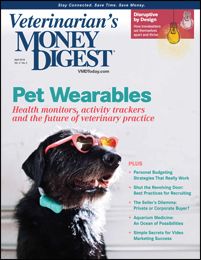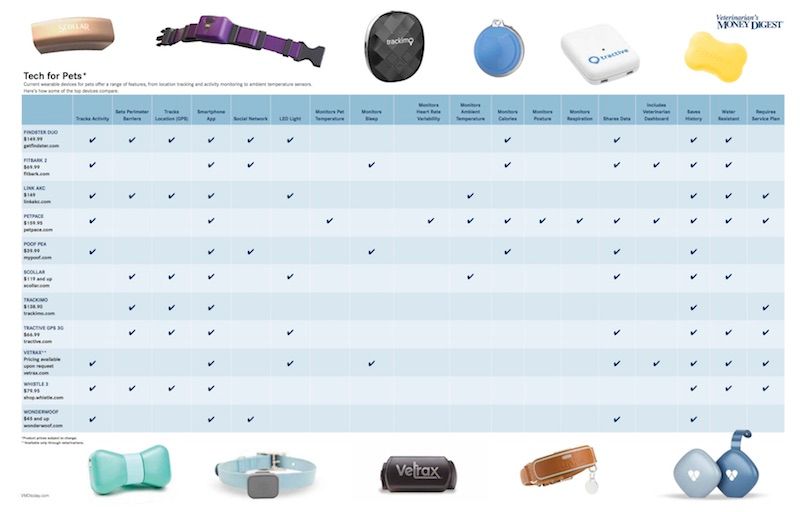Beyond Gadgets and Gizmos
We take a look at the potential impact of pet wearables on the veterinary practice of the future.

It seems the fitness tracker craze isn’t reserved for people. America’s seemingly endless love and fascination with pets has sparked a new trend: wearables. What impact this increasingly popular animal-centric technology will have on the practice of veterinary medicine remains to be seen.
The crux of the industry’s growth is the smart- product area of wearables, including fitness trackers, training systems, activity monitors, GPS trackers, cameras, smart vests and collars, emotion sensors, and health monitors. Electronic and Wi-Fi- enabled collars and cameras can monitor a pet’s location, its activity level and even its emotional state. Here we explore the growth and potential uses of activity monitors and trackers for dogs and cats.
A Booming Industry
The decision to equip pets with their own activity monitors is in line with the national trend of Americans treating pets like family members and thus outfitting them with similar comforts. Currently, 68 percent of American households1 have at least one pet and 77 percent of Americans own a smartphone2 — the paths were bound to cross.
According to research by Global Market Insights, the pet wearable market is poised to surpass $8 billion by 2024, largely as a result of increasing disposable income and adoption of pets.3 A company press release states, “Owners are increasing their spending on smart products that can be controlled remotely and monitor their pet’s health and fitness.”3
RELATED:
- 22 of the Pet Industry's Most Innovative Products
- Millennials Are Driving Growth of Holistic Pet Care
The market is merely responding to the expansion of wearable devices for people (e.g., Fitbit and Apple Watch) and turning toward pets and the profit potential they represent in the U.S. economy. Because 59 percent of cats and 54 percent of dogs in the United States are overweight or obese,4 
a tech solution seems feasible.
Addressing the issue in its 2017 pets edition, the Los Angeles Times reported that in the $66 billion pet industry, emerging pet technology represents a growing segment.5
“What started out as simple gadgets such as light-up collars have now evolved to high-quality GPS collars and wearable health-monitoring devices,” according to Tierra Bonaldi, an American Pet Products Association spokeswoman. “We have seen more and more traditional human companies get involved in pet products because they see to what lengths pet owners will go to care for their pets.”5
Aaron Massecar, PhD, program manager for veterinary innovation and entrepreneurship at 
the Texas A&M College of Veterinary Medicine
& Biomedical Sciences in College Station, said
 that while the pet wearable market “is still in its nascency,” many new players are emerging “as sensors become more ubiquitous and their use becomes more generally accepted. At the current time, it still seems to be a consumer-driven market as the clear application to the medical benefit of the animal has not been established yet for most veterinarians."



The main use for pet wearables, according to Dr. Massecar, continues to be GPS for tracking. “This solves the immediate consumer need of finding a lost pet and does so at a continually reduced cost to the owner,” he said.
Although this application has no immediate impact on the practice of veterinary medicine, “other companies are showing the relationship between activity level and nutritional requirements,” Dr. Massecar said. “This kind of information can help a veterinarian better understand the presence of possible allergens in a pet’s food.”
Although acceptance rates have not met expectations for these technologies, Dr. Massecar said he believes that “part of the reason for this could simply be because veterinarians are not trained to think about remote diagnostics as part of the treatment plan.”
As more pet owners look to preventive wellness as a means to avoid detrimental health conditions for their animals, “an increase in the desire to track activity and correlate that with animal health is foreseeable,” Dr. Massecar said. “As this trend grows, the veterinary profession must look at ways of incorporating these technologies into practice. At the same time, wearable companies will have to continue to demonstrate the efficacy of their products to veterinarians.”
Chad E. Dodd, DVM, CEO of Animatas Consulting and a member of the Veterinarian’s Money Digest® Editorial Advisory Board, said that one advantageous way veterinarians can use the data collected from these
monitors is as a component
for follow-up assessments,
which are often traditionally skewed by the
patient being examined
in the unfamiliar, sterile
environment of a veterinary hospital. “Monitoring
a pet’s chronic medical
conditions in its routine
environment will inevitably provide more accurate measures,” he said. “This allows veterinarians to create individualized treatment plans that will lead to better outcomes.”
Click to view full size version.
The long-term potential, according to Dr. Massecar: “If veterinarians and wearable companies can come together and begin providing 360-degree, 24/7
and real-time validated information about our pets, then we will not only be able to provide actionable insights for our pet’s care, but also increase the ability to predict the development of diseases.”
Increasing professional participation in the field depends on veterinarians’ curiosity about wearable technology, Dr. Massecar said: “Simply typing ‘pet wearable’ into Google produces a lot of information, from companies to market insights. If veterinarians are able to develop a healthy curiosity about the kinds of companies that are working in this space and think about how the information that wearables provide could help to deepen the understanding of a particular condition — with electrocardiographic monitoring, for example — then that curiosity will send them on a pathway that will likely make an early adopter out of the veterinarian.”
Even though most wearable technology companies focus their marketing efforts on consumers, they are not blind to the potential revenue stream — and collaboration — the veterinary industry presents. In fact, according to Dr. Massecar, wear- able companies are interested in veterinarians’ perspectives. “As veterinarians reach out to these companies, more robust products that better define use and enhance animal health will come,” he said.
One such company is FitBark, which has developed professional portals for veterinary schools, practitioners, boarding providers, trainers and dog walkers. Though geared predominantly toward pet owners, the sales force remains engaged with researchers on how activity monitoring could play a role in veterinary medicine, particularly with regard to mobility, nutrition, anxiety and skin conditions.
Davide Rossi, FitBark’s CEO, said that for veterinarians, wearable devices can serve as monitoring tools to collect longitudinal data and track patients’ progress. Although he did not have precise figures on how many veterinarians currently use the FitBark dashboard, the company promotes its data usage as an objective source of information to identify changes in activity and mobility levels, create exercise plans with activity targets, audit postsurgical compliance and monitor recovery from orthopedic surgery.

Vetrax, a monitoring system developed by AGL, takes a different approach. The company’s sensors, which are marketed as able to detect pet behaviors beyond running and rest — think shaking and scratching — are available only through the recommendation and oversight of
a veterinarian. The associated portal also acts as a client management system for veterinary practices by storing the contact information and billing history of the clients whose pets are outfitted with one of the sensors.
Even without overwhelming public support from the nation’s veterinary professionals, the data collected by these technology companies likely will find their way into veterinary medicine through alternate routes. Not only do pet owners relay information about their own pets, but researchers, food manufacturers, insurance providers and pharmaceutical companies have used data collected from activity trackers and health monitors to refine their products and support claims. The University of Cambridge in England recently released its findings from a 2017 One Health study that used FitBark to monitor the activity levels of sheep in preclinical orthopedic experiments.6 It is believed that the data collected from the monitors have the potential to improve treatment outcomes in humans and animals with orthopedic diseases.
For its part, Burlington, Massachusetts—based PetPace is taking the lead on exploring how pet monitors can recognize seizures in animals with the launch of its Canine Epilepsy Study. Its goal: develop the capability to detect and possibly predict seizures in dogs. “Understanding the
 true prevalence of seizure activity is invaluable
in our attempts to effectively manage epilepsy in dogs,” said Bob Murtaugh, DVM, MS, DACVIM, DACVECC, FCCM, lead investigator of the study. “The introduction of the PetPace technology will allow us, for the first time in veterinary medicine, to attempt just that — know exactly when, in real time and for how long, each patient has a seizure.”
By measuring seizures in real time, veterinarians “can now tailor treatment plans to the individual patients’ needs and provide pet parents with peace of mind through round-the-clock monitoring,” Dr. Dodd added.
Looking Ahead
Rossi predicts that it will soon become increasingly normal for pets to wear some form of a smart collar. “It’s going to become very easy to create a digital identity for pets, and that digital identity is going to make pet ownership a little easier, a little more efficient and a little more coordinated between family members and members of the veterinary community,” he said.
“It’s an exciting time for the animal health industry,” Dr. Dodd said. “Whether it’s the pioneers or the followers, the teams that pay heed to consumers’ needs and wants, help solve everyday problems, and deliver a great customer experience are going to be the ones that get rewarded. And hopefully, through their offerings, we can achieve better health outcomes for the animals in our care.”
Greg Kelly is a long-time health care writer and editor. He has written for the Physician’s Money Digest, Dentist’s Money Digest and Veterinarian’s Money Digest websites. He lives at the Jersey Shore and welcomes comments at gregkelly@monmouthbeachlife.com.
References:
- Springer J. 2017-2018 APPA National Pet Owners Survey. American Pet Products Association website. americanpetproducts.org/Uploads/MemServices/GPE2017_NPOS_Seminar.pdf. Published 2017. Accessed January 4, 2018.
- Rainie L, Perrin L. 10 facts about smartphones as the iPhone turns 10. PEW Research Center website. pewresearch.org/fact-tank/2017/06/28/10-facts-about-smartphones/. Published June 28, 2017. Accessed January 5, 2018.
- Pet wearable market worth over $8bn by 2024 [press release]. Selbyville, DE: Global Market Insights, Inc; August 21, 2017. gminsights.com/pressrelease/pet-wearable-market. Accessed January 17, 2018.
- 2016 Pet obesity survey results. Association for Pet Obesity Prevention website. petobesityprevention.org/2016. Published February 21, 2017. Accessed January 4, 2018.
- D’Angelo A. You won’t believe the tech toys we found for you and your pet. Los Angeles Times. August 26, 2017. latimes.com/style/pets/la-hm-pets-tech-20170827-story.html. Accessed January 17, 2018.
- 6. Newell K, Chitty J, Henson FM. “Patient reported outcomes” following experimental surgery-using telemetry to assess movement in experimental ovine models [published online October 31, 2017]. J Orthop Res. doi: 10.1002/jor.23790.

